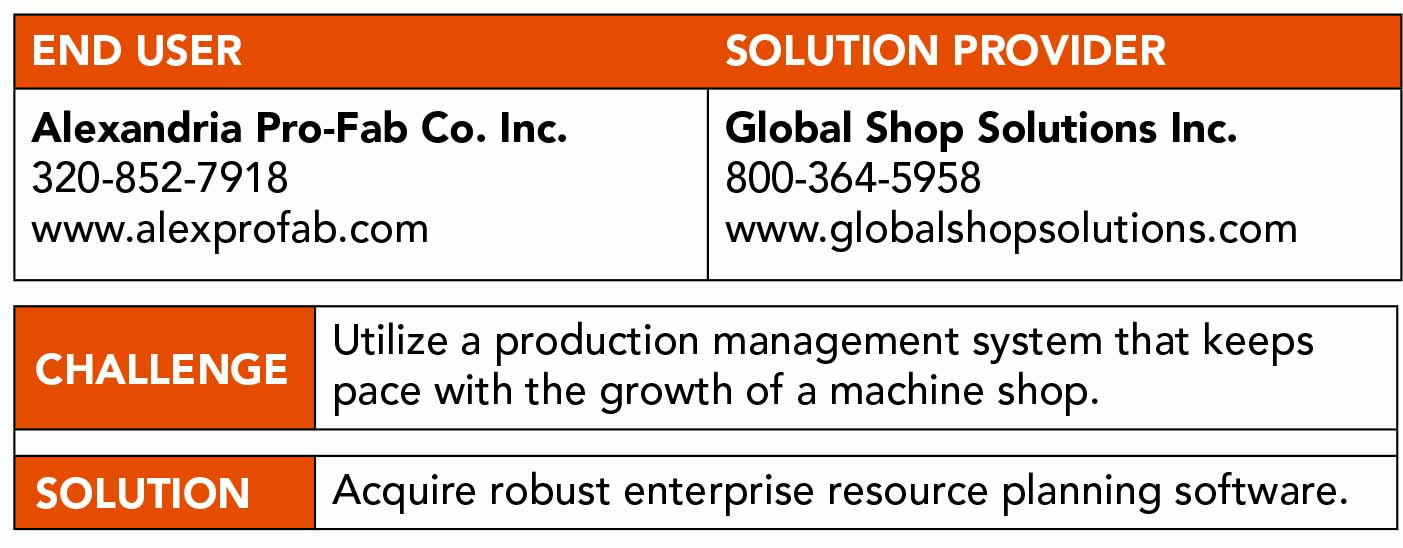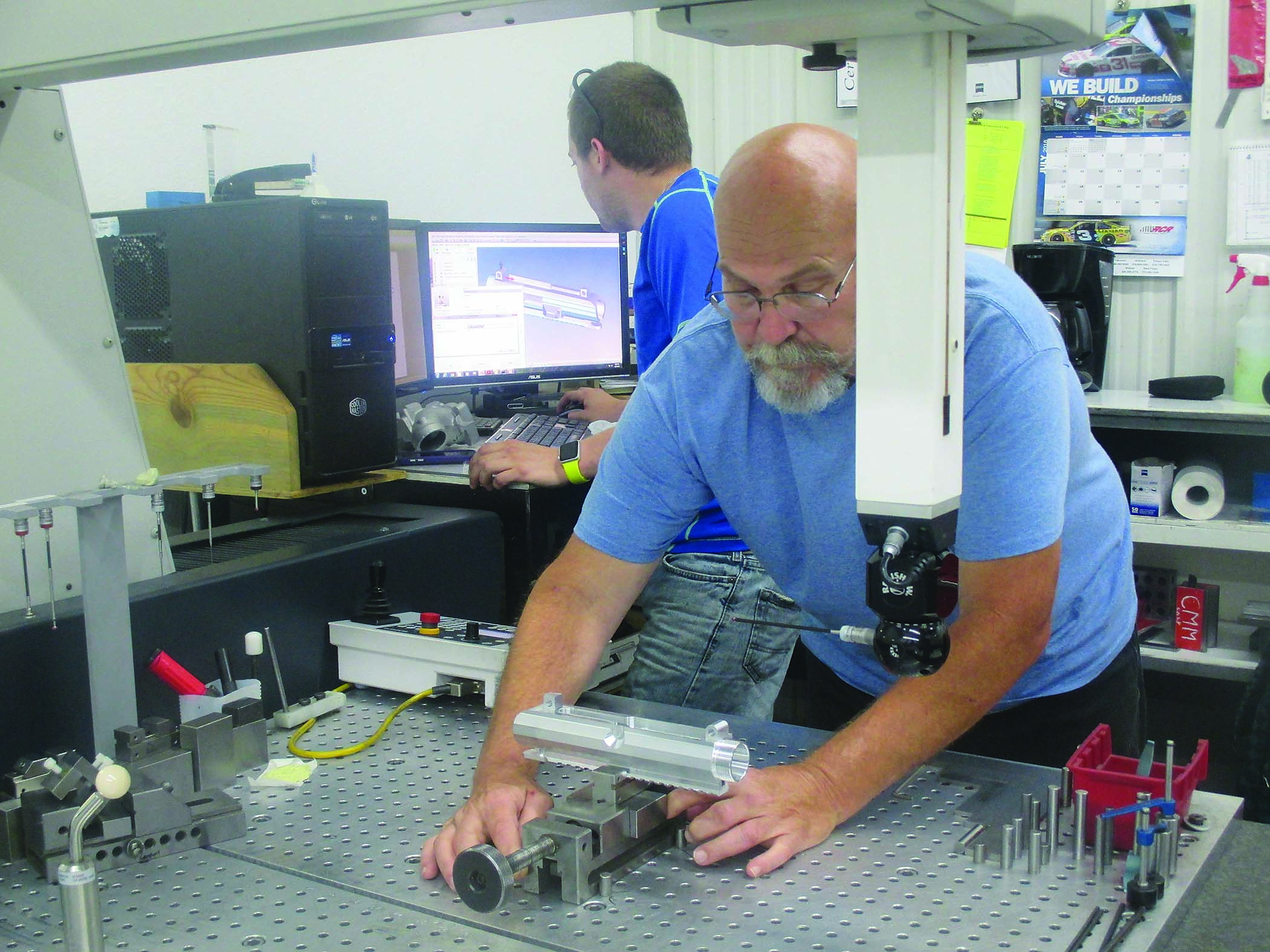Headquartered in Alexandria, Minnesota, Alexandria Pro-Fab Co. Inc.’s custom machining services involve CNC turning and milling (2D and 3D), five-axis milling, prototyping and machining. Production runs range from small to very large, and workpiece materials include steel, stainless steel, aluminum, brass and plastic, as well as castings and forgings.
As the company grew over the years from its humble founding in 1976 with one used welding machine to a contract machine shop with more than 150 employees operating out of a 100,000-sq.-ft. facility, Alexandria Pro-Fab’s production management system failed to keep up with the growth. In particular, the system offered minimal inventory management capabilities and was unable to accept electronic data interchange, or EDI, files from customers to simplify the order entry process.
Seeking a more up-to-date, robust enterprise resource planning system to resolve these and other shop floor challenges, Alexandria Pro-Fab turned to Global Shop Solutions Inc. in The Woodlands, Texas.

“Our previous system served us well when we were a smaller company, but the fact is we just outgrew it,” said Plant Manager Dave Dahl. “We needed more from our ERP software, and Global Shop Solutions fit all our needs as a growing enterprise.”
Alexandria Pro-Fab runs upward of 3,000 jobs annually. The company also stocks finished products for some customers, allowing them to draw from inventory as needed on a preset schedule. The manufacturer often starts producing these products months in advance of the actual due date, using forecasts received through EDI to have sufficient stock on hand for customers. Hence, the need for precise material movement and inventory management is paramount. And he said Global Shop Solutions’ ERP software is more than up to the task.
When running partial jobs, Dahl said the software makes it easy to track raw materials, parts, work in progress, or WIP, and finished goods as jobs progress. Order entry personnel use the work orders to create demand based on the requirements for material, machining and outside processing lead times. As operators machine the parts and log their results against the work orders, the software automatically tracks material usage and the status of each job.
“We do a lot of partials on the large stock orders, so every day we are ‘WIPing’ product to finished goods,” he said. “It might take several weeks to complete a job, but we need to WIP them every two or three days in order to ship them. With Global Shop Solutions’ ERP software, we know at any point in time how many partials we have, where they are and how many more we need to complete the job.”
To keep up with the high volume of jobs, Alexandria Pro-Fab regularly runs three shifts. The first shift always operates at full capacity, which can put a strain on the individual capacity of the CNC machines during the day. With only so much time available on each machine, accurate scheduling is essential for maximizing labor and machine efficiencies. Global Shop Solutions’ Advanced Planning & Scheduling application assists with the task by allowing flexible workweek scheduling. Depending on the projected workload and due dates, planners schedule each machine from a 40-hour workweek up to a 100-hour workweek.

“With APS, we can easily see where we have available time on our machines in case we need to move up a job or push others out,” Dahl said. “And if we decide to forward- or backward-schedule, the results are instantaneous. As soon as we make the change, the system immediately shows how it affects every other job on the schedule. We don’t have to wait a week for the system to reload, and we don’t have to pore over a spreadsheet with thousands of lines on it to
decipher what we just did.”
As a result of this ability to adjust schedules on the fly, Alexandria Pro-Fab has significantly raised on-time delivery rates from a percentage in the low 90s to an average of 97.6%. For its biggest customer, which buys nearly $20 million of product each year, the company has achieved 100% on-time delivery.
Since implementing the new software, Dahl said Alexandria Pro-Fab’s power to accurately identify job costs has substantially grown. Managers previously used the standard approach of assigning an hourly cost to each machine and adding the cost of materials for each job. However, this approach fails to consider hidden costs, such as unproductive time when operators are logged on to a job but not actively engaged in making a part. With the ERP software, operators now use Shop Floor Data Collection stations to electronically log on and off all jobs, allowing for more precise capture of labor time. Operators also use the stations to log their scrap and rework, which further refines the job costing process.
“With the old system, we would total up our labor and material costs and assume we made good margins,” he said. “In reality, we often had jobs going out the door for less than it cost us to make. With Global Shop Solutions, we can track and dig through data to easily find our true costs. This enables us to see when we’re not making the right margins and adjust our pricing as needed.”
Dahl considers the job costing capabilities as the primary benefit of the software.
“In today’s highly competitive markets, it’s critical to know exactly what a part cost when it ships out,” he said. “We can’t afford to assume that it cost $6 when it’s actually going out the door at $10. We need to know all our costs from start to finish, and we need the ability to look back and see costs, pricing and margins over time. With Global Shop Solutions, we can look back to the first day we went live with the system, and all the data is still there. As we have gotten more efficient over time, we can see our costs continually drop until we reach the point where we’re the best we can be at a particular job or process. Knowing what we’re actually spending versus guessing at it gives us real confidence in our pricing and our margins.”
Contact Details
Related Glossary Terms
- computer numerical control ( CNC)
computer numerical control ( CNC)
Microprocessor-based controller dedicated to a machine tool that permits the creation or modification of parts. Programmed numerical control activates the machine’s servos and spindle drives and controls the various machining operations. See DNC, direct numerical control; NC, numerical control.
- gang cutting ( milling)
gang cutting ( milling)
Machining with several cutters mounted on a single arbor, generally for simultaneous cutting.
- milling
milling
Machining operation in which metal or other material is removed by applying power to a rotating cutter. In vertical milling, the cutting tool is mounted vertically on the spindle. In horizontal milling, the cutting tool is mounted horizontally, either directly on the spindle or on an arbor. Horizontal milling is further broken down into conventional milling, where the cutter rotates opposite the direction of feed, or “up” into the workpiece; and climb milling, where the cutter rotates in the direction of feed, or “down” into the workpiece. Milling operations include plane or surface milling, endmilling, facemilling, angle milling, form milling and profiling.
- payload ( workload)
payload ( workload)
Maximum load that the robot can handle safely.
- turning
turning
Workpiece is held in a chuck, mounted on a face plate or secured between centers and rotated while a cutting tool, normally a single-point tool, is fed into it along its periphery or across its end or face. Takes the form of straight turning (cutting along the periphery of the workpiece); taper turning (creating a taper); step turning (turning different-size diameters on the same work); chamfering (beveling an edge or shoulder); facing (cutting on an end); turning threads (usually external but can be internal); roughing (high-volume metal removal); and finishing (final light cuts). Performed on lathes, turning centers, chucking machines, automatic screw machines and similar machines.



